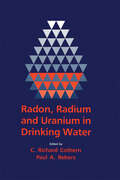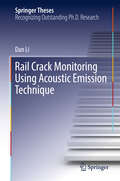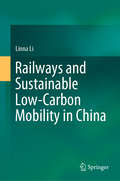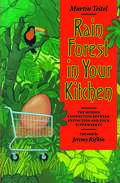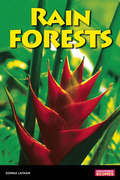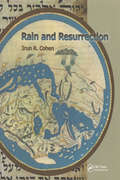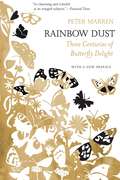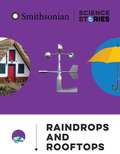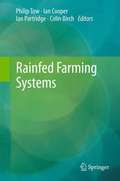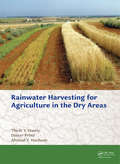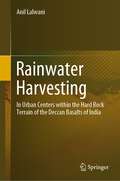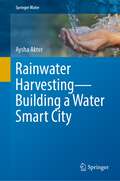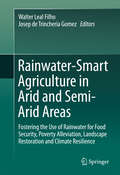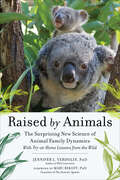- Table View
- List View
Radon, Radium, and Uranium in Drinking Water
by C. Richard CothernWith new regulations for radionuclides in drinking water, this volume will be valuable for understanding where radionuclides come from, how their prescence is determined, where humans come in contact with them, health effects consequences (both for individuals and communities), removal from water, disposal problems and cost implications.
Radzi's Incredible Facts: Mind-Blowing Facts to Make You the Smartest Kid Around!
by Radzi ChinyanganyaA book for curious kids filled with unforgettable facts, from the brilliant to the bizarre! What’s the furthest distance ever run without stopping? Which language has the most words? How many times do we blink each day, year, or in an entire lifetime? How deep is the deepest hole that’s ever been dug? How hot are the world’s hottest chilies? Do you know the answers? If not, then this fact book is for you.This fun and educational book for children aged 5-9 is packed with quirky questions and answers about every topic you can possibly think of. Learn about feminism, ears, pirates, and even belly buttons, Radzi’s Incredible Facts will have curious minds hooked. No question is too random for Radzi!This exciting children’s fact book offers:- Key topics for children, from bizarre facts about the human body and incredible historical figures, to unbelievable sporting feats and amazing animals.- An intriguing question and answer format that clearly groups topics to generate interest and engage young readers.- Content by the author of well-known UK children’s television personality Radzi Chinyanganya – former presenter of the BBC’s Blue Peter.- A balance of text and illustrations on each page, making it engaging for young readers.Kids can dazzle their friends and family with unforgettable facts and astounding information from former Blue Peter presenter Radzi Chinyanganya. Young minds are so inquisitive and always asking questions! Ever wondered where to find the answers to tricky and curious questions about everything, from sleep to snow and diseases to diamonds? Then look no further! This book is brimming with questions and answers you didn’t even know you needed.
Rail Crack Monitoring Using Acoustic Emission Technique (Springer Theses)
by Dan LiThis thesis provides an innovative strategy for rail crack monitoring using the acoustic emission (AE) technique. The field study presented is a significant improvement on laboratory studies in the literature in terms of complex rail profile and crack conditions as well as high operational noise. AE waves induced by crack propagation, crack closure, wheel-rail impact and operational noise were obtained through a series of laboratory and field tests, and analyzed by wavelet transform (WT) and synchrosqueezed wavelet transform (SWT). A wavelet power-based index and the enhanced SWT scalogram were sequentially proposed to classify AE waves induced by different mechanisms according to their energy distributions in the time–frequency domain. A novel crack sizing method taking advantage of crack closure-induced AE waves was developed based on fatigue tests in the laboratory. The propagation characteristics of AE waves in the rail were investigated, and Tsallis synchrosqueezed wavelet entropy (TSWE) with time was finally brought forward to detect and locate rail cracks in the field. The proposed strategy for detection, location and sizing of rail cracks helps to ensure the safe and smooth operation of the railway system. This thesis is of interest to graduate students, researchers and practitioners in the area of structural health monitoring.
Railroad Vehicle Dynamics: A Computational Approach
by Ahmed A. Shabana Khaled E. Zaazaa Hiroyuki SugiyamaThe methods of computational mechanics have been used extensively in modeling many physical systems. The use of multibody-system techniques, in particular, has been applied successfully in the study of various, fundamentally different applications. Railroad Vehicle Dynamics: A Computational Approach presents a computational multibody-system
Railway Brake Systems: Framework, Requirements, and Solutions (Lecture Notes in Mobility)
by Raphael PfaffThis book offers a timely introduction to railway brake systems. It introduces operational aspects as well as a set of rail vehicle specific requirements, such as wheel-rail contact and rail vehicle dynamics. It discusses the process of brake control, in particular for automatic pneumatic brake system and brake systems for multiple units. In turn, the book gives insights into braking force generation, covering both friction brake systems and regenerative brakes. It also describes performance calculations, discussing concepts for brake systems design. Despite the focus is mainly on European braking systems, the book identifies key and general aspects, thus offering an inspiring reading for researchers and professionals that are active both inside and outside of Europe.
Railways and Sustainable Low-Carbon Mobility in China
by Linna LiThis book explores the role of railways in developing sustainable low-carbon mobility by analyzing the intermodal relationship between railways and other transport modes. Focusing on geographical and governance perspectives, and taking China as a case study, it analyzes the competition and cooperation between and integration of railways and other transport modes, in order to provide guidance on future sustainable transport development. Firstly, the book examines the contribution of railways to low carbon emissions in China over recent decades by estimating the carbon dioxide emissions from various transport modes in China at national and regional levels using decomposition analysis. It then discusses the current competition and cooperation between railways and other transport modes, as well as their integration and the impact of their relationship on climate change. It also highlights how the competition between railways and other transport modes may change the passenger flows between city pairs and so alter transport carbon emissions and examines how cooperation and integration could improve passengers’ travel experience while at the same time reducing carbon emissions. Lastly, it addresses the implications for future sustainable transport development based on institutional analysis. Presenting multidisciplinary, sustainable transport research on the role of railways in reducing carbon emissions, and also offering policy recommendations for developing low-carbon, integrated transport in the future, this book is a valuable reference resource for graduates, researchers, and government managers responsible for transport development, urban planning and environmental policy.
Raimo Väyrynen: With a Foreword by Olli Rehn and a Preface by Allan Rosas (Pioneers in Arts, Humanities, Science, Engineering, Practice #28)
by Raimo VäyrynenThis book provides a broad overview of Professor Raimo Väyrynen’s academic work, his role in international research organizations, and his contributions to policy debates. It offers an interesting review of important political issues during the time span of half a century, from disarmament in Europe to the changing relationship between state sovereignty and transnational forces. Väyrynen has dealt with the changing agenda of peace and international relations, security and the arms race, and the world economy. This book provides comprehensive analyses of the regional and systemic structure of international relations, with the emphasis on conflicts and warfare between nations. It argues that while states, even smaller ones, still matter, transnational issues are increasingly important. Taking a historical perspective, the articles suggest that large-scale violence and arms races have been recurrent and cyclical phenomena in international relations. These events reflect the deep-seated inequalities in the political and economic systems which, moreover, vary considerably between regions. The publication is important reading for any researcher as well as students, policy-makers and the science-oriented public at large. • Traces the changing agenda of international relations from disarmament and the world economy to the changing relationship between state sovereignty and transnational forces. • Provides analyses of the regional and systemic structure in international relations, with the emphasis on conflicts and warfare. • Argues that large-scale violence and the arms race have been recurrent and cyclical phenomena in international relations. • Reviews important political issues from peace and conflict in Europe to the changing power relationship in the world.
Rain
by Cynthia BarnettRain is elemental, mysterious, precious, destructive. It is the subject of countless poems and paintings; the top of the weather report; the source of the world's water. Yet this is the first book to tell the story of rain. Cynthia Barnett's Rain begins four billion years ago with the torrents that filled the oceans, and builds to the storms of climate change. It weaves together science--the true shape of a raindrop, the mysteries of frog and fish rains--with the human story of our ambition to control rain, from ancient rain dances to the 2,203 miles of levees that attempt to straitjacket the Mississippi River. It offers a glimpse of our "founding forecaster," Thomas Jefferson, who measured every drizzle long before modern meteorology. Two centuries later, rainy skies would help inspire Morrissey's mopes and Kurt Cobain's grunge. Rain is also a travelogue, taking readers to Scotland to tell the surprising story of the mackintosh raincoat, and to India, where villagers extract the scent of rain from the monsoon-drenched earth and turn it into perfume. Now, after thousands of years spent praying for rain or worshiping it; burning witches at the stake to stop rain or sacrificing small children to bring it; mocking rain with irrigated agriculture and cities built in floodplains; even trying to blast rain out of the sky with mortars meant for war, humanity has finally managed to change the rain. Only not in ways we intended. As climate change upends rainfall patterns and unleashes increasingly severe storms and drought, Barnett shows rain to be a unifying force in a fractured world. Too much and not nearly enough, rain is a conversation we share, and this is a book for everyone who has ever experienced it.From the Hardcover edition.
Rain Forest in Your Kitchen: The Hidden Connection Between Extinction And Your Supermarket
by Jeremy Rifkin Martin TeitelThe biodiversity crisis -- the extinction of thousands of species of plants and animals -- is not just a faraway problem for scientists to solve. Instead, the crisis is as close as our backyards, our gardens, and our refrigerator shelves. This engaging, practical guide inspires average Americans to wield their consumer power in favor of protecting the world's plant and animal species.Environmentalist activist Martin Teitel offers compelling evidence that by slightly modifying how we shop, eat, and garden, we can collectively influence the operating decisions of today's corporate agribusiness and help preserve our precious genetic resources. Teitel offers strategies so simple that they require no significant lifestyle change or expense.
Rain Forests
by Donna LathamInvestigating a variety of biomes and today's natural and human threats to their preservation, this interactive series challenges young readers to look at how their own actions influence the planet's health. Four distinct environments are explored in detail, showcasing the assortment of plants and animals that inhabit these outdoor communities as well as how they have adapted to their surroundings. Offering fascinating facts on each ecosystem along with vocabulary-building sidebars, these guides show budding scientists how they can contribute towards ongoing conservation efforts. Showcasing one of the environment's most valuable biomes, this overview centers on the planet's rain forests, reviewing the greenhouse gases and the accelerating extinction of species that jeopardize this vital ecosystem's future.
Rain and Resurrection How the Talmud and Science Read the World
by Irun CohenThis book presents a set of essays interpreting excerpts from the Talmud that illustrate values essential to Western science. It includes another set of essays interpreting the function of interpretation in the method of science, to associate Talmudic and post-modern concepts.
Rainbow Dust: Three Centuries of Butterfly Delight
by Peter MarrenLike fluttering shards of stained glass, butterflies possess a unique power to pierce and stir the human soul. Indeed, the ancient Greeks explicitly equated the two in a single word, psyche, so that from early times butterflies were not only a form of life, but also an idea. Profound and deeply personal, written with both wisdom and wit, Peter Marren’s Rainbow Dust explores this idea of butterflies—the why behind the mysterious power of these insects we do not flee, but rather chase. At the age of five, Marren had his “Nabokov Moment,” catching his first butterfly and feeling the dust of its colored scales between his fingers. It was a moment that would launch a lifetime’s fascination rivaling that of the famed novelist—a fascination that put both in good company. From the butterfly collecting and rearing craze that consumed North America and Europe for more than two hundred years (a hobby that in some cases bordered on madness), to the potent allure of butterfly iconography in contemporary advertisements and their use in spearheading calls to conserve and restore habitats (even though butterflies are essentially economically worthless), Marren unveils the many ways in which butterflies inspire us as objects of beauty and as symbols both transient and transcendent. Floating around the globe and through the whole gamut of human thought, from art and literature to religion and science, Rainbow Dust is a cultural history rather than merely a natural one, a tribute to butterflies’ power to surprise, entertain, and obsess us. With a sway that far surpasses their fragile anatomy and gentle beat, butterfly wings draw us into the prismatic wonders of the natural world—and, in the words of Marren, these wonders take flight.
Rainbow Science: Discover How Rainbows Are Made, with 23 Fun Experiments & Colorful Activities!
by Artemis RoehrigThis colorful book explores the fascinating science of rainbows and includes a pair of fun prism glasses so kids can see rainbows right before their eyes! I spy a rainbow! But where do rainbows come from? How are they made? Rainbow Science celebrates everything rainbow, from the science of sunlight to the prism in raindrops to how our eyes see all the colors that make up a rainbow, in this colorful activity book. Kids can be a rainbow scientist and learn how to search for rainbows, make their own rainbows with a hose, spin homemade color wheels, blow multicolored bubbles, make a kaleidoscope, and more. Simple materials lists and straightforward, age-appropriate experiment steps are accompanied by scientific explanations for each activity. Engaging illustrations give easy-to-understand explanations about rainbow science and the math and physics of light refraction. Tucked into the pocket on the inside front cover is a fun pair of wearable glasses so kids can see rainbows right before their eyes. This book is a celebration of rainbows for kids who love science experiments, weather, and hands-on activities!
Raindrops and Rooftops: Below-Grade Reader (Smithsonian Science Stories)
by Smithsonian InstitutionGrade 3. 2018. 56 pages. Lexile range: 510–560L. Raindrops and Rooftops reader serves as an informational text resource that is incorporated into many lessons in the Smithsonian Science for the Classroom™ module How Do Weather and Climate Affect Our Lives? Topics include: Weather Woman; Surprise! It's Raining; Climate Tour; Wild and Wacky Weather; Gusts and Gales; Up on the Rooftop; and Don't Rain on the Parade.
Rainfed Farming Systems
by Ian Partridge Philip Tow Colin Birch Ian CooperWhile a good grasp of the many separate aspects of agriculture is important, it is equally essential for all those involved in agriculture to understand the functioning of the farming system as a whole and how it can be best managed. It is necessary to re-assess and understand rain-fed farming systems around the world and to find ways to improve the selection, design and operation of such systems for long term productivity, profitability and sustainability. The components of the system must operate together efficiently; yet many of the relationships and interactions are not clearly understood. Appreciation of these matters and how they are affected by external influences or inputs are important for decision making and for achieving desirable outcomes for the farm as a whole. This book analyses common rain-fed farming systems and defines the principles and practices important to their effective functioning and management.
Rainfed Farming Systems
by Ian Partridge Philip Tow Colin Birch Ian CooperWhile a good grasp of the many separate aspects of agriculture is important, it is equally essential for all those involved in agriculture to understand the functioning of the farming system as a whole and how it can be best managed. It is necessary to re-assess and understand rain-fed farming systems around the world and to find ways to improve the selection, design and operation of such systems for long term productivity, profitability and sustainability. The components of the system must operate together efficiently; yet many of the relationships and interactions are not clearly understood. Appreciation of these matters and how they are affected by external influences or inputs are important for decision making and for achieving desirable outcomes for the farm as a whole. This book analyses common rain-fed farming systems and defines the principles and practices important to their effective functioning and management.
Rainwater Harvesting for Agriculture in the Dry Areas
by Theib Y. Oweis Dieter Prinz Ahmed Y. HachumDry areas suffer not only from limited rainfall but alsonatural leakage'-90% of rainwater is lost directly or indirectly, and is unavailable for agriculture or domestic use. Water harvesting is a low-cost, easy-to-use, environmentally-friendly way to recover a large part of this lost water. How does water harvesting work? Which sites or areas are
Rainwater Harvesting: In Urban Centers within the Hard Rock Terrain of the Deccan Basalts of India
by Anil LalwaniOur dependency on groundwater resources and overuse thereof has led to a decline in water table so that in the last couple of decades the focus has shifted back to the traditional practices of rainwater harvesting, and ways and means have been sought to promote Rainwater harvesting in Urban areas to recharge the stressed groundwater systems. This book discusses in brief the classifications of Rainwater harvesting, and the various rainwater harvesting systems that are currently applied. The most important aspect for achieving any groundwater recharge is the availability of source water, this can be evaluated by analyzing the monsoon rainfall pattern, its frequency, number of rainy days, and maximum rainfall in a day and its variation in space and time. The Deccan basalts are one of the most enigmatic rocks in India and pose a very difficult task when it comes to ground water exploration and groundwater recharge, especially in the urban areas where due to constraint of space one needs to resort to borewells for recharge purpose. It is important for any such undertaking to understand the applicability and sustainability aspects of Rainwater harvesting as it is being practiced. This book tries to differentiate the Basaltic Aquifers from the other hard-rock Aquifers, and highlights the difficulties in trying to implement rainwater harvesting by groundwater recharge with the basaltic terrain. It also deals with the issue of long term sustainability of roof top Rainwater to meet the growing demands of fresh water. It also highlights some of the shortcomings in the methodologies used and the requirements for being considered in the various categories of green building rating agencies. It furthermore clarifies the possibility and limitations of dependence of roof top harvesting in addressing the question of water shortages, which is of common occurrence within most urban centres of India. It also helps in clarifying major misconceptions that are currently prevailing regarding Roof top Rainwater harvesting especially within the low capacity aquifers within the hard rock terrain of the Deccan basalts.
Rainwater Harvesting—Building a Water Smart City (Springer Water)
by Aysha AkterThis book introduces the readers to possible aspects of the rainwater harvesting system against urbanization to plan, design, and implement. Practical applications of rainwater harvesting to supplement potable water, stormwater management, greywater reuse, and managed aquifer recharge are included. Along with conventional practices, advanced technologies for conceptualizing, data collection and processing, test procedures, and design principles are provided to illustrate the theory. This book is a pathway to a water smart city, example problems reflect the solutions for harvested water quantity and/or quality and afterward. Socio-economic assessments are incorporated to explore comprehensive knowledge. The book covers an interdisciplinary field, thus, suitable for students, researchers, and professionals associated with rainwater harvesting system development and management
Rainwater-Smart Agriculture in Arid and Semi-Arid Areas
by Walter Leal Filho Josep de Trincheria GomezThis book introduces state-of-the-art approaches, methods and research, focusing on smart management of rainwater. In addition, it provides an overview of projects from across the world, illustrating how rainwater-smart management has been implemented in drylands. Focusing on the scientific perspective it demonstrates how rural dryland agriculture can be improved. It also documents the wealth of rainwater-smart know-how available today, and replicates and transfers results to other countries and regions, to encourage cross-sector interactions among various stakeholders, such as practitioners from governmental and public organisations, policy- and decision-makers, and teaching staff from academic scientific institutions. The contributors showcase vital lessons learned from research, field projects and best-practice examples. They address the integrated use of rainwater harvesting management with landscape restoration practices and water-, and climate-smart agriculture for food security and poverty alleviation in arid and semi-arid areas. Original research, combined with the contributors’ synthetic approach, lays a foundation for new concepts and ideas. Through case studies and research reports, the book discusses all the relevant issues necessary for the comprehensive analysis and successful implementation of the technologies in rainwater management. Highlighting the working principles and technical recommendations with regard to cost-efficient rainwater-smart solutions, it is of interest to practitioners. It is also a valuable resource for academic specialists, professionals and students, since many development agencies are funding rainwater harvesting for irrigation purposes.
Raised by Animals: The Surprising New Science of Animal Family Dynamics
by Jennifer L. VerdolinWhen it comes to family matters, do humans know best? Leading animal behaviorist Dr. Jennifer Verdolin argues otherwise in this eye-opening book. Welcome to the wild world of raising a family in the animal kingdom . . . sometimes shocking, often ingenious! Every species can surprise us: Chimps have a knack for minimizing temper tantrums, and owl chicks have a remarkable gift for sharing. A prairie vole knows exactly when his stressed-out partner needs a massage. And anyone who considers reptiles “cold-blooded” should consider the caecilian, a snakelike animal from Kenya: After laying eggs, the mother grows a fatty layer of skin, which her babies eat after hatching (not one of the book’s many lessons from the wild to be tried at home!). Along the way Verdolin challenges our often counterproductive beliefs about what families ought to be like and how we should feel. By finding common ground with our furry, feathered, and even slimy cousins, we can gain new insight on what “natural” parenting really means—and perhaps do a better job of forgiving ourselves for those days when we’re “only human”!
Raising AI: An Essential Guide to Parenting Our Future
by De KaiFrom the pioneer of translation AIs like Google, Yahoo, and Bing translate, an accessible and authoritative guide to AI—as well as a framework of empowerment for a future with our artificial children.Included in J.P. Morgan's Summer Reading List Included in The Next Big Idea Club&’s June 2025 Must-Read BooksAIs are not gods or slaves, but our children. All day long, your YouTube AI, your Reddit AI, your Instagram AI, and a hundred others adoringly watch and learn to imitate your behavior. They&’re attention-seeking children who want your approval.Our cultures are being shaped by 8 billion humans and perhaps 800 billion AIs. Our artificial children began adopting us 10–20 years ago; now these massively powerful influencers are tweens.How&’s your parenting?Longtime AI trailblazer De Kai brings decades of his paradigm-shifting work at the nexus of artificial intelligence and society to make sense of the AI age. How does &“the automation of thought&” impact our minds? Should we be afraid?What should each of us do as the responsible adults in the room? In Hollywood movies, AI destroys humanity. But with our unconscious minds under the influence of AI, humanity may destroy humanity before AI gets a chance to.Written for the general reader, as well as thought leaders, scientists, parents, and goofballs, Raising AI navigates the revolution to our attitudes and ideas in a world of AI cohabitants. Society can not only survive the AI revolution but flourish in a more humane, compassionate, and understanding world—amongst our artificial children.
Raising Oysters (Fountas & Pinnell LLI Purple #Level R)
by Sarah BrockettSome people think oysters are gross, slimy blobs. Others think these slippery shellfish taste wonderfully delicious. Some people value oysters for their possible secret treasure: a pearl growing inside.
